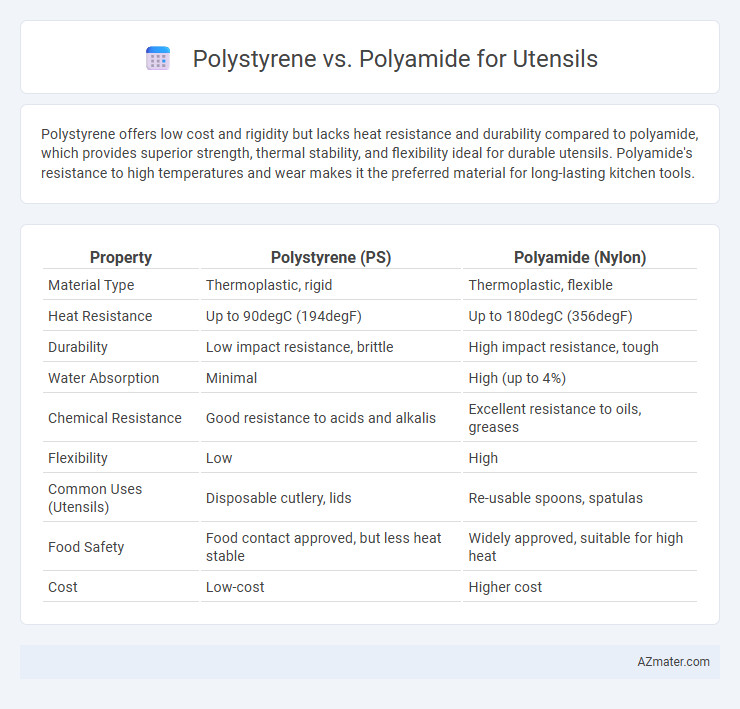Polystyrene offers low cost and rigidity but lacks heat resistance and durability compared to polyamide, which provides superior strength, thermal stability, and flexibility ideal for durable utensils. Polyamide's resistance to high temperatures and wear makes it the preferred material for long-lasting kitchen tools.
Table of Comparison
| Property | Polystyrene (PS) | Polyamide (Nylon) |
|---|---|---|
| Material Type | Thermoplastic, rigid | Thermoplastic, flexible |
| Heat Resistance | Up to 90degC (194degF) | Up to 180degC (356degF) |
| Durability | Low impact resistance, brittle | High impact resistance, tough |
| Water Absorption | Minimal | High (up to 4%) |
| Chemical Resistance | Good resistance to acids and alkalis | Excellent resistance to oils, greases |
| Flexibility | Low | High |
| Common Uses (Utensils) | Disposable cutlery, lids | Re-usable spoons, spatulas |
| Food Safety | Food contact approved, but less heat stable | Widely approved, suitable for high heat |
| Cost | Low-cost | Higher cost |
Introduction to Polystyrene and Polyamide
Polystyrene is a lightweight, rigid thermoplastic polymer commonly used for disposable utensils due to its low cost and ease of molding. Polyamide, also known as nylon, is a durable, heat-resistant polymer favored for reusable utensils because of its strength and resistance to chemical wear. Understanding the material properties of polystyrene and polyamide is crucial for selecting the appropriate polymer in utensil manufacturing applications.
Chemical Composition and Structure
Polystyrene consists of a hydrocarbon polymer made from styrene monomers, featuring a rigid, amorphous structure that offers good chemical resistance but is prone to brittleness and limited heat tolerance. Polyamide, commonly known as nylon, comprises repeating units linked by amide bonds, resulting in a semi-crystalline structure that provides superior strength, flexibility, and higher thermal stability compared to polystyrene. The chemical structure of polyamide includes polar amide groups that enhance moisture absorption and mechanical resilience, making it more suitable for utensils exposed to heat and physical stress.
Manufacturing Processes Compared
Polystyrene utensils are typically produced through injection molding and extrusion processes, allowing for rapid mass production with high dimensional accuracy and low material costs. Polyamide utensils, usually made from nylon, require more complex manufacturing methods such as injection molding with higher temperature and pressure settings, resulting in stronger, more durable products resistant to heat and chemicals. The choice between polystyrene and polyamide manufacturing impacts production speed, environmental resistance, and final product performance in utensil applications.
Physical Properties: Strength and Flexibility
Polystyrene offers high rigidity and excellent strength but tends to be brittle and lacks flexibility, making it prone to cracking under impact. Polyamide (nylon) delivers superior strength combined with exceptional flexibility and impact resistance, allowing it to withstand bending and heavy use without breaking. The choice between polystyrene and polyamide for utensils hinges on the need for durability and flexibility, with polyamide preferred for more demanding applications requiring toughness.
Heat Resistance and Thermal Stability
Polystyrene offers limited heat resistance, typically withstanding temperatures up to 80degC, making it less suitable for high-temperature cooking utensils. Polyamide (nylon) exhibits superior thermal stability, enduring temperatures up to 200degC, which allows it to maintain structural integrity and resist deformation during prolonged heat exposure. This thermal resilience makes polyamide a preferred choice for utensils used in cooking and food preparation requiring sustained heat.
Safety and Food Contact Regulations
Polystyrene utensils pose concerns due to potential styrene monomer migration, which is regulated by the FDA and EFSA to ensure limits do not exceed safety thresholds for food contact materials. Polyamide (Nylon) is generally favored for utensils because of its high thermal resistance and compliance with food contact regulations including FDA 21 CFR 177.1500 and EU Framework Regulation (EC) No 1935/2004, minimizing risk of chemical leachates. Both materials require compliance testing, but polyamide's stability and lower migration rates make it a safer choice for repeated use with hot and acidic foods.
Environmental Impact and Recyclability
Polystyrene utensils are lightweight and inexpensive but pose significant environmental challenges due to their slow biodegradability and difficulty in recycling, often contributing to plastic pollution. Polyamide utensils, while more durable and heat-resistant, offer better recyclability and a lower environmental footprint when processed through proper waste management systems. Choosing polyamide over polystyrene can reduce landfill accumulation and improve circular economy outcomes in the utensil industry.
Cost Analysis: Polystyrene vs Polyamide
Polystyrene utensils typically incur lower manufacturing costs due to cheaper raw materials and simpler processing methods compared to polyamide. Polyamide utensils, while more expensive, offer superior durability and heat resistance, justifying higher initial expenses through longer product lifespan. Cost analysis reveals polystyrene is favorable for single-use applications, whereas polyamide suits reusable utensils requiring enhanced strength.
Typical Applications in Utensil Production
Polystyrene is widely used in disposable utensils such as cutlery, cups, and plates due to its affordability, lightweight nature, and ability to be molded into various shapes. Polyamide, also known as nylon, finds applications in reusable kitchen utensils like spatulas, tongs, and cooking spoons because of its superior heat resistance, durability, and flexibility. The choice between polystyrene and polyamide in utensil production depends on factors like intended use, temperature tolerance, and desired lifespan of the product.
Choosing the Right Material: Key Considerations
Polystyrene offers lightweight and cost-effective options for disposable utensils but lacks durability and heat resistance compared to polyamide. Polyamide, known for its strength, flexibility, and higher thermal stability, is suitable for reusable utensils that require longer lifespan and resistance to heat exposure. Key considerations when choosing between the two include intended use, durability requirements, temperature tolerance, and environmental impact to ensure optimal performance and sustainability in utensil applications.

Infographic: Polystyrene vs Polyamide for Utensil
 azmater.com
azmater.com